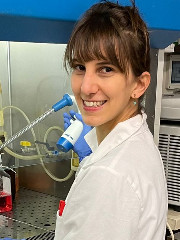
Fabrizia Bonacina (Italy)
University of Milan Department of Pharmacological and Biomolecular scienceAuthor Of 2 Presentations
O004 - Role of the Interleukin-1 Receptor/Toll Like Receptor TIR8/SIGIRR in experimental atherosclerosis (ID 1235)
Abstract
Background and Aims
TIR8/SIGIRR dampens the excessive activation mediated by ILRs and TLRs agonism and thus is a key regulator of inflammation. Aim of this study was to investigate the role of TIR8 in atherosclerosis.
Methods
8 weeks old-LDLR KO and TIR8/LDLR double KO (DKO) male mice were fed with standard diet (STD) or cholesterol-enriched diet (WTD) for 12 weeks. Plasma lipid profiling, extensive immunophenotyping and histological analysis of the atherosclerotic plaques were then performed.
Results
TIR8 deletion in STD-fed LDLR KO mice impacts circulating immune cell profile: decreased percentage of T lymphocytes (-29%, p<0.001) and increased percentage of B cells (+14%, p<0.05) were observed compared to LDLR KO mice, as well as increased mature Natural Killer cells (+13%, p<0.0001), as already described in the TIR8 KO mouse model. When fed a cholesterol rich diet for 12 weeks to induce atherosclerosis, in addition to changes observed on STD, also circulating levels of monocytes increased in DKO mice compared to LDL-R KO mice (mean 1464 vs 910 cells/ul, p<0.05). These changes in immune profile, however, did not affect atherosclerotic plaque area or stability. Similarly, no differences in plasma lipid profile were observed.
Conclusions
TIR8 deficiency in LDLR KO mice increases NKs and monocytes blood levels compared to LDL-R KO mice. Changes in these immune subsets, however, do not impact the development of atherosclerosis.
O023 - The low-density lipoprotein receptor (LDL-R) is an immune-metabolic checkpoint during CD8 T lymphocytes activation (ID 1251)
Abstract
Background and Aims
Activation of T lymphocytes combines functional to metabolic rewiring of cell machinery, including cholesterol homeostasis. Here we evaluated the role of LDLR on T cell biology
Methods
Immunophenotypic characterization of CD8T cells from WT and LDLR KO mice was performed in vitro (anti-CD3/CD28) and in vivo (vaccination, homeostatic proliferation) coupled to proteomic and confocal analysis on isolated CD8T cells. In parallel, T cells from FH were tested.
Results
LDLR deficiency dampened CD8+ proliferation (-35%, p<0.01) paralleled by a reduction in INFγ production (-39.6%, p<0.01). In vivo antigen-specific activation by ovalbumin vaccination, but not homeostatic proliferation, resulted in a decreased proliferation and cytokines production (↓IFNγ p<0.001,↓IL13 p<0.01,↓perforin p<0.05) in CD8+ of KO mice. Incubation with LDL significantly increased the proliferation in WT but not KO CD8T cells (+11%,p<0.01), a phenotype that was compensated by a reprogramming of de-novo synthesis in KO CD8T cells. Proteomic analysis revealed an impairment in glycolysis and OXPHOS associated to downregulation of pathways downstream to mTORC1 activation, possibly link to its reduced lysosomal localization observed in KO CD8T cells.
CD8+ T cells from FH subjects proliferated less (-36%, p>0.05) compared to sex- and age-matched controls and presented a decreased granzyme production (-60.3%, p<0.01) when CD8 memory response was tested in vitro with virus-derived peptides in seasonal influenza vaccinated matched controls and FH subjects.
Conclusions
LDLR plays a critical role in regulating the immunometabolic responses in CD8+ Tcells, and thus might represent a checkpoint linking cellular cholesterol metabolism to adaptive immune response.
Presenter of 1 Presentation
O023 - The low-density lipoprotein receptor (LDL-R) is an immune-metabolic checkpoint during CD8 T lymphocytes activation (ID 1251)
Abstract
Background and Aims
Activation of T lymphocytes combines functional to metabolic rewiring of cell machinery, including cholesterol homeostasis. Here we evaluated the role of LDLR on T cell biology
Methods
Immunophenotypic characterization of CD8T cells from WT and LDLR KO mice was performed in vitro (anti-CD3/CD28) and in vivo (vaccination, homeostatic proliferation) coupled to proteomic and confocal analysis on isolated CD8T cells. In parallel, T cells from FH were tested.
Results
LDLR deficiency dampened CD8+ proliferation (-35%, p<0.01) paralleled by a reduction in INFγ production (-39.6%, p<0.01). In vivo antigen-specific activation by ovalbumin vaccination, but not homeostatic proliferation, resulted in a decreased proliferation and cytokines production (↓IFNγ p<0.001,↓IL13 p<0.01,↓perforin p<0.05) in CD8+ of KO mice. Incubation with LDL significantly increased the proliferation in WT but not KO CD8T cells (+11%,p<0.01), a phenotype that was compensated by a reprogramming of de-novo synthesis in KO CD8T cells. Proteomic analysis revealed an impairment in glycolysis and OXPHOS associated to downregulation of pathways downstream to mTORC1 activation, possibly link to its reduced lysosomal localization observed in KO CD8T cells.
CD8+ T cells from FH subjects proliferated less (-36%, p>0.05) compared to sex- and age-matched controls and presented a decreased granzyme production (-60.3%, p<0.01) when CD8 memory response was tested in vitro with virus-derived peptides in seasonal influenza vaccinated matched controls and FH subjects.
Conclusions
LDLR plays a critical role in regulating the immunometabolic responses in CD8+ Tcells, and thus might represent a checkpoint linking cellular cholesterol metabolism to adaptive immune response.
